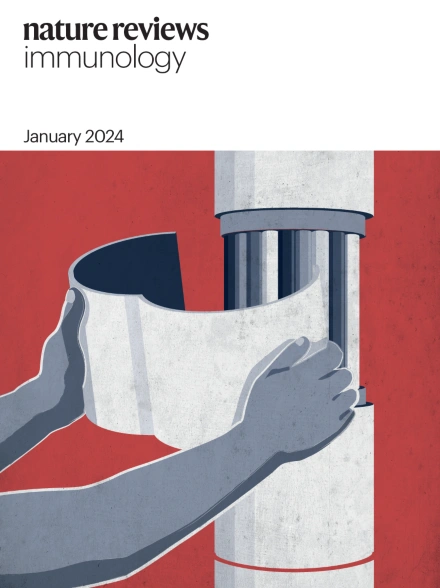Patterns of pathogenesis in innate immunity: insights from C. elegans
IF 60.9
1区 医学
Q1 IMMUNOLOGY
引用次数: 0
Abstract
The cells in barrier tissues can distinguish pathogenic from commensal bacteria and target inflammatory responses only in the context of infection. As such, these cells must be able to identify pathogen infection specifically and not just the presence of an infectious organism, because many innocuous bacteria express the ligands that activate innate immunity in other contexts. Unravelling the mechanisms that underly this specificity, however, is challenging. Free-living nematodes, such as Caenorhabditis elegans, are faced with a similar dilemma, as they live in microorganism-rich habitats and eat bacteria as their source of nutrition. Nematodes lost canonical mechanisms of pattern recognition during their evolution and have instead evolved mechanisms to identify specific ligands or symptoms in the host that indicate active infection with an infectious microorganism. Here we review how C. elegans surveys for these patterns of pathogenesis to activate innate immune defences. Collectively, this work demonstrates that using C. elegans as an experimental platform to study host–pathogen interactions at barrier surfaces reveals primordial and fundamentally important principles of innate immune sensing in the animal branch of the tree of life. In this Review, Tse-Kang, Wani and Pukkila-Worley discuss how nematodes, such as Caenorhabditis elegans, rely on ‘patterns of pathogenesis’ as opposed to the sensing of specific ligands by pattern-recognition receptors to activate innate immune responses. They explain why this approach to immune surveillance is beneficial to C. elegans and consider how studies in C. elegans can inform our understanding of mammalian immunity.


先天免疫的发病模式:秀丽隐杆线虫的见解
屏障组织中的细胞可以区分病原菌和共生菌,只有在感染的情况下才能靶向炎症反应。因此,这些细胞必须能够特异性地识别病原体感染,而不仅仅是传染性生物体的存在,因为许多无害细菌表达在其他情况下激活先天免疫的配体。然而,揭示这种特异性背后的机制是具有挑战性的。自由生活的线虫,如秀丽隐杆线虫,也面临着类似的困境,因为它们生活在微生物丰富的栖息地,并以细菌作为营养来源。线虫在进化过程中失去了典型的模式识别机制,取而代之的是进化出识别宿主体内特定配体或症状的机制,这些机制表明感染了感染性微生物。在这里,我们回顾秀丽隐杆线虫如何调查这些发病模式来激活先天免疫防御。总的来说,这项工作表明,使用秀丽隐杆线虫作为实验平台来研究屏障表面的宿主-病原体相互作用,揭示了生命之树动物分支中先天免疫感知的原始和根本重要原理。
本文章由计算机程序翻译,如有差异,请以英文原文为准。
求助全文
约1分钟内获得全文
求助全文
来源期刊

Nature Reviews Immunology
医学-免疫学
CiteScore
93.40
自引率
0.40%
发文量
131
审稿时长
6-12 weeks
期刊介绍:
Nature Reviews Immunology is a journal that provides comprehensive coverage of all areas of immunology, including fundamental mechanisms and applied aspects. It has two international standard serial numbers (ISSN): 1474-1733 for print and 1474-1741 for online. In addition to review articles, the journal also features recent developments and new primary papers in the field, as well as reflections on influential people, papers, and events in the development of immunology. The subjects covered by Nature Reviews Immunology include allergy and asthma, autoimmunity, antigen processing and presentation, apoptosis and cell death, chemokines and chemokine receptors, cytokines and cytokine receptors, development and function of cells of the immune system, haematopoiesis, infection and immunity, immunotherapy, innate immunity, mucosal immunology and the microbiota, regulation of the immune response, signalling in the immune system, transplantation, tumour immunology and immunotherapy, and vaccine development.
 求助内容:
求助内容: 应助结果提醒方式:
应助结果提醒方式:


